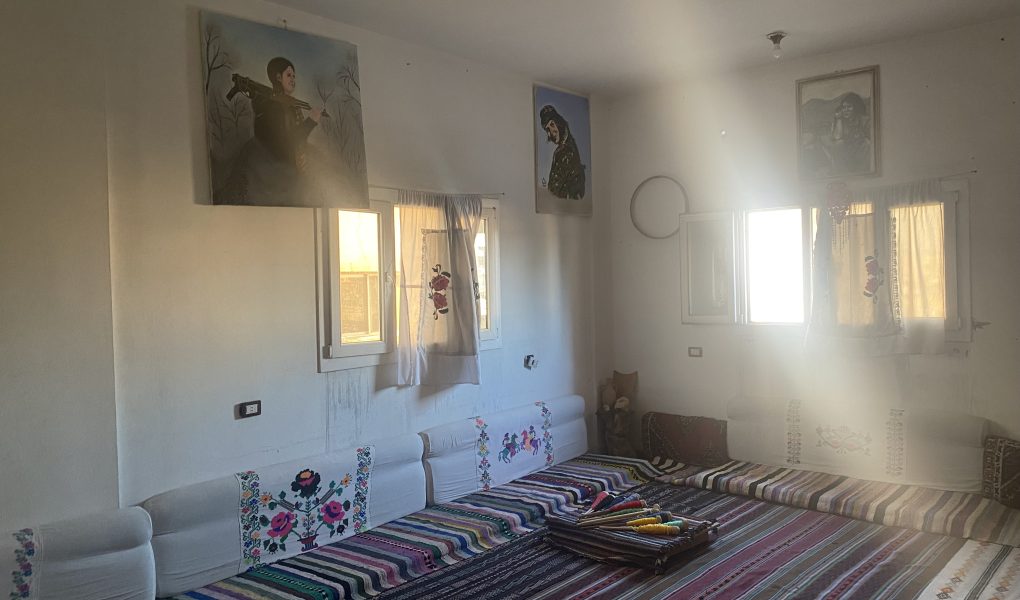Hîlala Zêrîn translates to “golden crescent moon” and refers to the Fertile Crescent, the territory between the Zagros and Taurus mountains. This region was the birthplace of the Neolithic revolution and the location of the earliest civilizations and cities. Archaeologists have also found evidence of ancient matriarchal societies in the Fertile Crescent.

Hîlala Zêrîn is a women’s cultural movement which links cultural techniques and historical research to women’s liberation. Women gather to sing, play instruments, write poems, paint, do theater, handcrafts and many more cultural works. Research into the communal way of life of Neolithic societies is at the center of the work that Hîlala Zêrîn does. It serves as a main source of inspiration for women’s cultural expression. As the main organization of women’s culture in North and East Syria, Hîlala Zêrîn has a center in each canton and organizes different educational spaces. In 2024, they opened a new academy for women’s culture and arts in Heseke. Young women go there to study with the aim to fulfill their dream of expressing themselves, improving their skills and sharing the love for art and culture with other women. Some of the young women share their artistic skills after their studies by teaching in the different centers of Hîlala Zêrîn.

We got the chance to visit the Center of Hîlala Zêrîn in Qamishlo. We had some tea, talked about their work and got to know it by listening to a rehearsal of young women preparing for Newroz. We then looked at many of the art pieces that were done at the center. “As soon as when we entered the center, we heard some music in the background and saw some young women sitting together and sharing a meal. After their break, the women students came together for rehearsal.“, said Ann, an internationalist that was also visiting the center with us.
The center is a place where children and women come together to learn music instruments, sing, paint etc. The idea is to build a strong relationship to their own cultural heritage – its symbols, its rhythms and its stories. To do so, the research of cultural expression and resistance against oppression and assimilation is a key work done by Hîlala Zêrîn. “We search for moments of women’s liberation within history. For example, we visited different families to listen to tales and stories that are not written down yet and include these stories in our cultural work. Those oral histories are an especially important source to uncover our hidden history and not let it be forgotten The last years we did a project where older women shared cultural stories and the next generations retold them. It was really wonderful to see the culture living through generations and a lot of the older women cried.“ said Rûken, a member of Hîlala Zêrîn.

By revitalizing culture, Hîlala Zêrîn also opens a space to discuss the meaning of culture, traditions and societal values. “We broke a border because before women were not allowed to play instruments or hold hands while dancing. That is something we changed.“ Rûken continues. And she stresses that culture is not only about arts but, even more importantly, about food, clothes and the everyday life that all of us create together. And all of that is constantly changing. Through everyday culture, Hîlala Zêrîn also forms new approaches , changes traditional rules and discusses how to strengthen and rebuild ourselves as women and how to reject patriarchal-capitalist culture. These discussions are not solely done in the center but are a constant topic when talking to families and at societal events. The building up of feminist culture against the capitalist appropriation of culture is a pillar of the works of Hîlala Zêrîn. Rûken states: “Women’s culture is the start of women’s revolution, the vanguard role of women in the revolution can only be filled with women’s culture.”

The works of Hîlala Zêrîn aim to enable children and women to express themselves. Especially for children, it is important to get to know their culture and to grow up with more knowledge about their society and themselves. One expression of these efforts are different festivals Hîlala Zêrîn organizes. The children’s festival is one moment where children and families come together and the children perform. There is also a regular women’s festival organized to share women’s art and culture. These festivals are precious moments of sharing culture and building up communal spaces that bring society together. It is through art and culture that we share emotions, discuss our common values and create a life filled with joy and hope. At the same time, these festivals are also a way to bring together different cultural groups and artists from all of Kurdistan such as Rohilat (East Kurdistan) and Başur (South Kurdistan) that visit and share their specific music and art. Furthermore, it is an important moment to bring together Arab, Kurdish, Yezidi and Assyrian cultures in North and East Syria. Building up democratic structures together also means knowing each other through our respective roots, history and culture. In this spirit, there a groups that are specific Arab or Kurdish to keep their cultures alive but there are also mixed groups with the aim to form and live the common culture of North and East Syria.

Cultural variety was on display in the different rooms we visited at the center. Besides the room for singing and music rehearsals, there are rooms for painting, playing theater, dancing and handcrafts. The internationalist Ann further expressed: “One of my favorite moments was seeing a group of young women from Afrin rehearsing for their performance for the Newroz festivities in Qamishlo. Knowing that most of them just arrived in the last months to Qamishlo – after being forced to flee from Shebha – and seeing them now sing together was a powerful and strong moment. You could really feel how culture and resistance are strongly linked with each other.” Indeed, when we later saw their official performance on the Newroz stage, it was a wonderful sight: a real symbol of resistance through arts and culture and a timeless representation of women sticking together.

To read more on the topic of Hîlala Zêrîn, check out this Kongra Star article.

